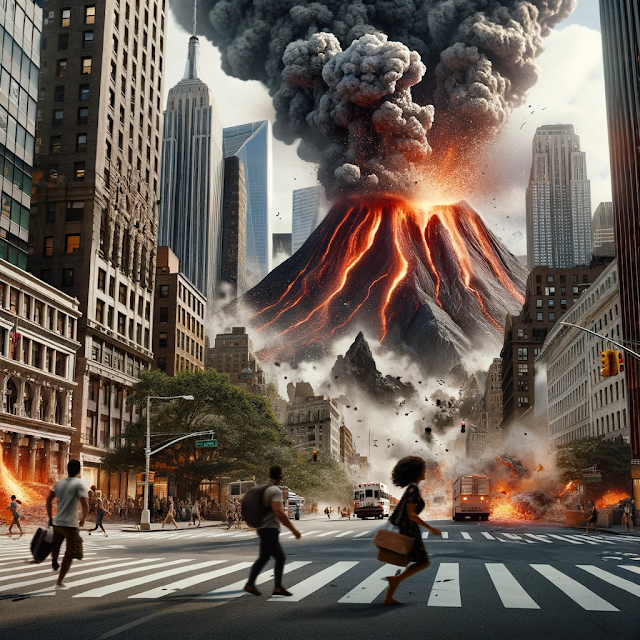Is California's Supervolcano About to Erupt?
By Rameen
Here's What
Science Says:
California's
supervolcano, the Long Valley Caldera, is stirring. Recent activity suggests
potential signs of life, sparking concerns about its potential to erupt. But
what does the science say?
The Quakes: A
Symptom of Activity
Researchers at
the California Institute of Technology (Caltech) have detected over 2,000
earthquakes in the Long Valley Caldera in recent times. Such seismic activity
in a supervolcano is enough to raise eyebrows. The team, keen to understand if
these tremors heralded an impending catastrophic eruption, delved deep into the
heart of the caldera.
Understanding the
Underground
Caltech
scientists embarked on a detailed investigation, capturing underground images
of the caldera. The primary aim was to determine whether these tremors
indicated an increasing risk of eruption or if they signaled the caldera
settling down.
Their findings
were reassuring. The recent seismic activity, they discovered, is due to the
release of fluids and gases as the region cools and stabilizes. Zhongwen Zhan,
the study's lead author, clarified, "We don't believe the region is on the
brink of another supervolcanic eruption. However, as it cools, it might release
gases and fluids, which could cause earthquakes and minor eruptions."
The Long Valley
Caldera is no stranger to massive eruptions. About 767,000 years ago, it
experienced a colossal explosion, ejecting 140 miles of volcanic material into
the atmosphere, leaving a mark on the landscape. For context, in May 1980, the
region saw four earthquakes, each of magnitude 6.
Modern
Techniques: Peeking Below the Surface
To better
understand the caldera's activity, Zhan's team employed distributed acoustic
sensing (DAS). They strategically placed seismometers across the Eastern Sierra
region and laid out cables spanning 62 miles of the caldera. Over 18 months,
they detected more than 2,000 seismic events, the majority of which were
imperceptible to humans.
Utilizing machine
learning, the team processed these measurements to generate a comprehensive
image, pinpointing each quake's location.
Expert Opinions
Emily
Montgomery-Brown, a Long Valley Caldera specialist not affiliated with the
study, noted that earthquake swarms began in 2011. By 2020, the region
witnessed ground deformation, with the land rising and tremors dissipating,
leading to a quieter period. However, Montgomery-Brown cautions that an
eruption is still a possibility.
The Magma
Reservoir: A Reservoir of Power
A 2018 study
illuminated the caldera's staggering magma storage: 240 cubic miles, enough to
fill 400 million Olympic swimming pools. In comparison, the 1980 Mount St
Helens eruption spewed a mere 0.29 cubic miles of volcanic material.
Montgomery-Brown
added, "Even if the Long Valley magma reservoir is dormant, there are
other magma pockets in the vicinity."
Are There Any Warning Signs?
Volcanoes are
complex geological systems, and predicting their activity with absolute
certainty is challenging. However, scientists use a variety of signs and
monitoring techniques to assess the likelihood of an eruption. Here are some
scientific signs that a volcano may become active or erupt soon:
Seismic Activity:
Increased earthquake activity (seismicity) is often the most reliable indicator
of an impending eruption. As magma rises towards the surface, it can fracture
surrounding rock, causing small earthquakes.
Ground
Deformation: The movement or intrusion of magma can cause the ground to bulge
or deform. Using instruments like tiltmeters and GPS, scientists can measure
even tiny changes in the volcano's shape.
Gas Emissions: As
magma nears the surface, it releases gases. Monitoring stations can detect
increased levels of volcanic gases like sulfur dioxide (SO2), carbon dioxide
(CO2), and water vapor.
Temperature
Changes: The temperature at the volcano's surface can increase due to the
approaching magma. This can be observed directly or with thermal imaging.
Changes in
Volcanic Lakes: Some volcanoes have lakes in their craters. Changes in the
water's temperature, color, or chemistry can signal volcanic activity.
Phreatic
Eruptions: These are small steam-driven explosions caused when groundwater is
heated by magma. They can be precursors to larger eruptions.
Audible Sounds:
As magma moves or gases escape, they can create rumbling sounds or a roaring
noise, which can sometimes be heard from the volcano.
Visual Changes:
New vents or cracks may appear, or existing ones may become more active. There
might also be an increase in the emission of steam or ash.
Historical
Patterns: Some volcanoes have patterns of eruptions. By studying a volcano's
eruption history, scientists can sometimes predict when it might erupt again.
Animal Behavior:
While not strictly scientific, there are anecdotal reports of animals acting
unusually before eruptions, possibly because they sense the increased seismic
activity or changes in gas emissions.
It's essential to
understand that while these signs can indicate increased volcanic activity,
they don't guarantee an eruption. Some volcanoes show signs of activity for
years without erupting, while others can become active with little warning.
Scientists use a combination of these signs, continuous monitoring, and
advanced models to assess and forecast volcanic activity.
While the Long
Valley Caldera is showing signs of activity, current scientific data suggests
that a supervolcanic eruption is not imminent. Nevertheless, the sheer volume
of magma beneath emphasizes the need for continuous monitoring and
understanding of this geological marvel. After all, nature often surprises us,
and it's always best to be prepared.

.jpeg)

Comments
Post a Comment